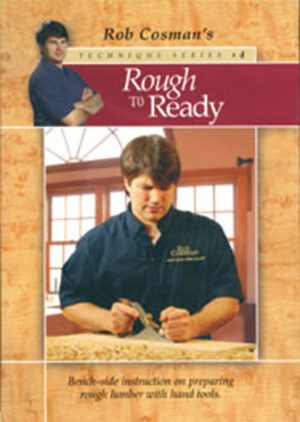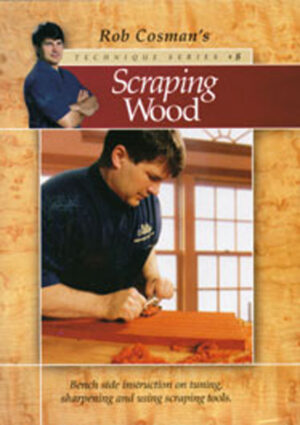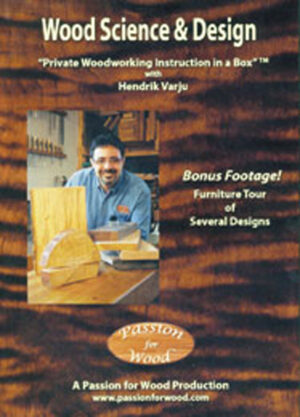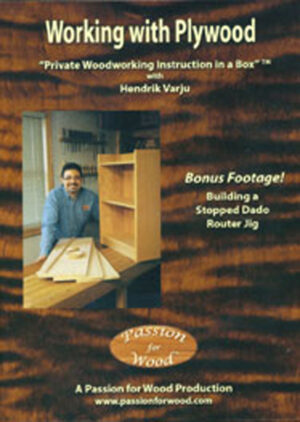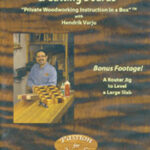END GRAIN TABLE TOPS & CUTTING BOARDS DVD
$100.00
Private Woodworking Instruction in a Box
with Hendrik Varju
Produced by Passion for Wood, Ontario, Canada
ISBN 978-0-9881280-7-1
As reviewed in The Australian Woodworker Issue 186
The ‘Butcher’s Block’ was once a familiar sight on the sawdust strewn floors of suburban butcher shops. It stood close to a metre tall and was about 600 or 700mm in diameter.
Made by upturning a section of log and mounting it on three or four rudimentary legs, it offered a solid, end-grain ‘table’ on which meat was chopped and cut.
The descendants of those old Butcher’s Blocks are the comparatively dainty cutting boards of today. Most have surfaces that present the long grain of the wood to to the cook’s or butcher’s knife.
Long grain surfaces are easily cut and scored and even in a home kitchen, a board is unlikely to last more than a year or two without being in need of refurbishment.
End-grain surfaces are much tougher. As Hendrik Varju points out at the start of this video presentation, the wood can be thought of as a bundle of ‘straws’, all standing vertically. This means that as the knife comes in contact with the wood, it tends to part these ‘straws’, separating, rather than severing them. And the stiffness of the ‘straws’ leads them to recover – a kind of self-healing process that allows the surface to maintain its integrity and appearance for much longer than one comprised of long grain.
There is nevertheless a good reason why end-grain boards are rare by comparison with their long grain cousins. This is that making them requires a good deal more work and skill.
It is the purpose of this, the latest of Hendrik Varju’s instructional DVDs, to help the viewer to develop the necessary skill.
He begins with a discussion about basic design and a comment that the techniques which he uses to make cutting boards can be equally applied to other projects such as table tops and chess boards.
In his usual painstaking manner, Varju demonstrates the way in which the individual boards are prepared – how they are begun by gluing together a long grain slab from which the elements of the final design can then be cut.
He describes the methods he uses to ensure that the surfaces of first the long grain slab and then the end grain slab do not require extensive finishing work.
For instance, in addition to what may appear a large number of clamps, he uses cauls at the ends when gluing up the long grain slab and he scrapes away excess glue before it has dried. While this part of the process is time consuming, it leaves only a minimal amount of clean-up to be done on the finished slab.
After no more than a few sweeps with a sharp plane, the rest of the work can be done on a machine.
(Hendrik Varju uses the US/Canadian names ‘jointer’ and ‘planer’ for the machines which in this region are more commonly called ‘planer’ or ‘planer/jointer’ and ‘thicknesser’.)
We might envy Hendrik for his 20″ thicknesser, but he points out that the workpiece used for the demonstration could also be handled by the kind of 12″ portable thicknesser possessed by many recreational woodworkers.
The regular dimensions of the final end grain slab are maintained by the use of dowels between each of the elements. While these contribute to the strength and long term stability of the cutting board, their major purpose during construction is to keep the board surfaces flat.
Using the techniques shown for the precise placement of the dowels, they practically eliminate any necessity for major re-working of the surfaces.
Therefore the rest of the work normally consists of perhaps some planing but more likely only sanding. For this Varju suggests using first a belt and then an orbital sander.
A router method of trimming the edges of the board is then shown, followed by a technique for cutting a small decorative chamfer on the top and vertical edges.
The application of the finish gives Varju an opportunity to examine the main possibilities, their advantages and disadvantages, before recommending the one he believes most suitable.
The brand names of these products are different to those available in this region but since he discusses each in terms of its chemical composition, this is of no consequence.
With the cutting board complete and the finish applied, attention is returned to the time when the clamps are first removed from an end-grain slab.
When something goes wrong while the glue is curing, the surfaces of a board may prove too distorted to allow the usual methods of finishing.
In the final segment of this video, Hendrik shows how his custom-made router levelling jig can be used to re-surface and restore the board (noting that the same jig is also useful for levelling slabs or burls).
In common with his usual practice, Hendrik Varju adds a few snippets of woodworking wisdom. Here, they are related to the tightness of joints, the value of hand made gifts and the way in which even simple projects can remind us of why we do woodworking.
It is, however, one of his much earlier statements that is likely to stick in the memory.
When speaking about the gluing up of the long grain slab, he makes a remark to the effect that furniture is meant to last hundreds of years and when putting on the clamps and making sure every tiny gap is closed and every edge is placed precisely where it ought to be, he is recognising that this is his last chance to make sure that the project will fulfill its promise.
It seems reasonable to suggest that a similar philosophy guides the production of his video presentations.
Duration: 6hrs, 33 mins, 3 discs
DVD – English – NTSC

